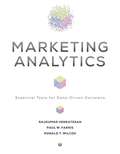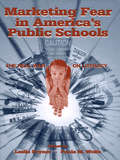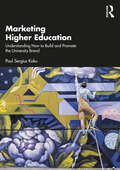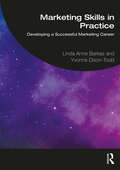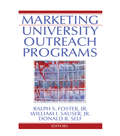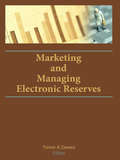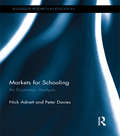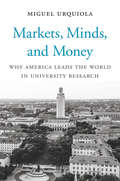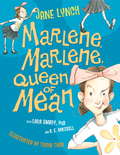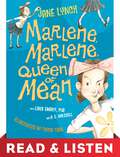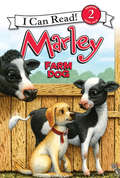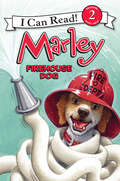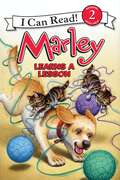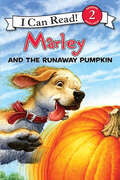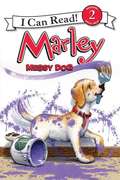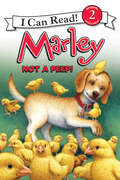- Table View
- List View
Marketing Analytics: Essential Tools for Data-Driven Decisions (Darden Business Series)
by Paul W. Farris Rajkumar Venkatesan Ronald T. WilcoxThe authors of the pioneering Cutting-Edge Marketing Analytics return to the vital conversation of leveraging big data with Marketing Analytics: Essential Tools for Data-Driven Decisions, which updates and expands on the earlier book as we enter the 2020s. As they illustrate, big data analytics is the engine that drives marketing, providing a forward-looking, predictive perspective for marketing decision-making. The book presents actual cases and data, allowing readers invaluable real-world instruction. The cases show how to identify relevant data, choose the best analytics technique, and question the link between marketing plans and customer behavior. Dealing with actual scenarios sheds light on the most pressing marketing questions, such as setting the optimal price for one’s product or designing effective digital marketing campaigns. Big data is currently the most powerful resource to the marketing professional, and this book illustrates how to fully harness that power to effectively maximize marketing efforts.
Marketing Fear in America's Public Schools: The Real War on Literacy
by Leslie Poynor Paula M. WolfeMarketing Fear in America's Public Schools: The Real War on Literacy is an eye-opening examination of the real world consequences of the political pressures and influences on teachers today. In particular, it looks at how the political actions of the conservative right disempower and control teachers, school districts, parents, and children through an atmosphere of fear used as a strategy to ensure that schools follow the conservative political agenda supporting and imposing mandates such as increased accountability, high stakes testing, and direct intense direct-instruction phonics programs. The book offers a unique look not at not only what the conservative factions are doing but why. The volume includes chapters on: *resistance to the conservative agenda; *national and/or federal agendas and actions that directly or indirectly contribute to the privatization and corporate control of public education; *the linkage of federal policy to the disappearance or promotion of particular philosophical and pedagogical approaches; and *the role of the media in perpetuating the agendas of the corporate and political right. Many teachers across the U.S. are frustrated and angry about the outside legislative constraints placed on their work, but at the same time frightened of losing their jobs and/or being faced with a lawsuit. The book's premise is that one must understand the motives behind the current educational "reforms" in order to resist them. The editors and contributors envision the volume as a voice for an alternative to compliance with unreasonable mandates--and thus as a message of hope. Marketing Fear in America's Public Schools: The Real War on Literacy is important reading for teachers; teacher educators; education students; school administrators and other education professionals; researchers concerned with literacy, critical theory, pedagogy, and educational policy; and parents and community activists concerned with the politics of schooling and school reform. It is will serve well as a text in a range of courses across the field of education. A Web site for the book can be found at http://www.erlbaum.com/poynor.
Marketing Higher Education: Understanding How to Build and Promote the University Brand
by Paul Sergius KokuThis book provides a comprehensive and accessible guide to marketing Higher Education institutions, discussing how universities are service providers and how education is a service, both of which need to be defined and marketed together. Unlike the current offering available on the subject, this book provides a uniquely applied approach, linking the theory of marketing practice to the Higher Education sector through real life case studies and examples. Each topic is covered in depth, including marketing segmentation, pricing, location, brand management, internationalization, and expansion. Overarchingly, the book considers how to develop and promote the university as a product and as a brand. Two case studies from real life universities in a broad range of locations are provided at the end of each chapter, alongside questions to aid understanding and application. Holistic and practical, Marketing Higher Education is an ideal guide for academics and students studying services marketing, Higher Education management and leadership, and marketing in the public sector. It will also be an invaluable resource for professionals working in Higher Education administration looking to develop their skills and understanding of marketing and brand building.
Marketing Higher and Further Education: An Educator's Guide to Promoting Courses, Departments and Institutions (Creating Success Ser.)
by Gibbs, Paul Knapp, MichaelA manual for anyone wishing to market higher or further education. It offers business-oriented guidance for readers whose main preoccupation may not be marketing itself, but who nonetheless need access to promotion skills, and it covers theory, practice and case studies.
Marketing Intelligent Design
by Frank S. RavitchRecently a new battle has emerged between science and religion. The battle has focused on intelligent design (ID) and the numerous legal, philosophical, and educational concerns surrounding it. Resolution of these concerns centers on two questions: Is ID science? And is ID religion? Despite the fact that ID does not meet the standards of scientific rigor, ID proponents have been able to create a remarkably well-designed marketing plan aimed at imposing a theistic naturalism in schools and scientific discourse. Both the ID movement and some of its most vociferous opponents have a vested interest in suggesting that science, especially evolutionary biology, and religion are incompatible. This book presents a philosophical and legal counterpoint by demonstrating the compatibility between religion and evolutionary biology and the incompatibility between ID and mainstream science.
Marketing Schools, Marketing Cities: Who Wins and Who Loses When Schools Become Urban Amenities
by Maia Bloomfield CucchiaraDiscuss real estate with any young family and the subject of schools is certain to come up--in fact, it will likely be a crucial factor in determining where that family lives. Not merely institutions of learning, schools have increasingly become a sign of a neighborhood's vitality, and city planners have ever more explicitly promoted "good schools" as a means of attracting more affluent families to urban areas, a dynamic process that Maia Bloomfield Cucchiara critically examines in Marketing Schools, Marketing Cities. Focusing on Philadelphia's Center City Schools Initiative, she shows how education policy makes overt attempts to prevent, or at least slow, middle-class flight to the suburbs. Navigating complex ethical terrain, she balances the successes of such policies in strengthening urban schools and communities against the inherent social injustices they propagate--the further marginalization and disempowerment of lowerclass families. By asking what happens when affluent parents become "valued customers," Marketing Schools, Marketing Cities uncovers a problematic relationship between public institutions and private markets, where the former are used to leverage the latter to effect urban transformations.
Marketing Schools, Marketing Cities: Who Wins and Who Loses When Schools Become Urban Amenities
by Maia Bloomfield CucchiaraDiscuss real estate with any young family and the subject of schools is certain to come up—in fact, it will likely be a crucial factor in determining where that family lives. Not merely institutions of learning, schools have increasingly become a sign of a neighborhood’s vitality, and city planners have ever more explicitly promoted “good schools” as a means of attracting more affluent families to urban areas, a dynamic process that Maia Bloomfield Cucchiara critically examines in Marketing Schools, Marketing Cities. Focusing on Philadelphia’s Center City Schools Initiative, she shows how education policy makes overt attempts to prevent, or at least slow, middle-class flight to the suburbs. Navigating complex ethical terrain, she balances the successes of such policies in strengthening urban schools and communities against the inherent social injustices they propagate—the further marginalization and disempowerment of lowerclass families. By asking what happens when affluent parents become “valued customers,” Marketing Schools, Marketing Cities uncovers a problematic relationship between public institutions and private markets, where the former are used to leverage the latter to effect urban transformations.
Marketing Skills in Practice: Developing a Successful Marketing Career
by Linda Anne Barkas Yvonne Dixon-ToddBased around research into marketing education and marketing practice, Marketing Skills in Practice: Developing a Successful Marketing Career helps students embarking on their career to develop their professional identity, as well as the key skills required by employers in the industry. Divided into four core sections, the book begins with an overview of the field of marketing. Section two shows students how to relate practice to their own transferable skills, while section three gives students the opportunity to consider how they lead, develop, and manage within marketing. Section four provides students with the opportunity to reflect on their own learning and identify what knowledge and skills they have enhanced for their future careers. Fundamentally, the book identifies the key skills required in the marketing industry whilst also addressing the challenge of developing a career in leading and managing in a marketing context. Theoretical aspects are applied through real-life cases, practical examples and a themed case study, coupled with tasks that allow students to test and apply their knowledge to a workplace scenario, all of which are adaptable for hybrid teaching methods. Unique in its focus on employability, this text is suitable for all marketing students embarking on a career in the field, and particularly as core reading for any modules based on Marketing in Practice and Professional Development. Online resources include PowerPoint slides for lecturers and an instructor’s manual, which includes lesson plans, tasks, suggested answers, and a test bank with answers.
Marketing University Outreach Programs
by Donald Self Ralph S Foster William I SauserDiscover the successful marketing strategies of programs which have extended the resources of a university to its community. Marketing University Outreach Programs covers all aspects of continuing education program construction and the marketing process for positioning the university into the public. This book begins to eradicate academicians&’ fears of marketing by showing them a contemporary marketing plan using terminology and examples familiar to them.Seventeen contributors--professors, administrators, and outreach professionals--comprehensively describe the strategies being successfully used to extend the resources of a university to its community through programs of extension, public service, and continuing education. Although many existing models of the education process contain parallels to elements in a generic marketing process, education is not viewed as a consumer product. Even educators may not view themselves as marketers involved in a marketing process. This attitude can place barriers between understanding the marketing process and how it relates to education. Marketing University Outreach Programs helps educators overcome these potential barriers; it explains marketing as a comprehensive process using terminology and examples which university extension and education professionals will find familiar and understandable.Application-oriented, it cites numerous examples of how the marketing process can be put to use immediately. Each chapter explores in-depth a separate segment of the marketing process involved in public university outreach programs: issue-based versus discipline-based programs program delivery and delivery technology funding outreach programs comprehensive promotional strategy customer service long-range planning marketing research information resources future trends model programsThis book is of value to the faculty of universities, specifically those in the disciplines with a mandate for professional renewal or recertification (engineering, medicine, education); faculty and professional staff in divisions of continuing education; program leadership in cooperative extension organizations (as well as those in other identifiable university extension units); and faculty affiliated with applied research centers. Members of professional associations focused on higher education outreach can also successfully apply these strategies.
Marketing and Managing Electronic Reserves
by Trevor A. DawesGet practical solutions to the problems faced when implementing an electronic reserve service!Academic libraries that provide electronic reserve services offer convenient access to information to their students and faculty while gaining numerous other advantages, such as reducing both loss and staff workload. Marketing and Managing Electronic Reserves presents leading authorities with practical solutions to the challenges in effectively integrating electronic reserves services and marketing them to users. This book provides positive approaches that any academic library considering the implementation of an electronic reserve operation can use. All factors are considered, including size of institution, the relationship between the library and academic departments, and the budget and plan for marketing the service.More and more colleges and universities are implementing distance education programs, highlighting the increasing need for remote access to information in the library, including reserve material. But executing monumental change is always difficult. Marketing and Managing Electronic Reserves tackles the difficult issues, discussing various libraries&’ journeys in bringing about the changes needed to remain the central information source for students and faculty. Problems inherent in the evolution from traditional reserve services to electronic reserves are examined, offering effective strategies for smooth transition. Whatever type of system you are considering, from homegrown to commercial to hybrid electronic reserves service, this book can help. Marketing and Managing Electronic Reserves explains how others tackled challenges, such as: implementing Endeavor&’s Voyager Integrated Library System and the software used for authenticating users handling copyright compliance integration of electronic reserves into course management systems moving from a paper-based to a Web-based course reserve system offering and marketing one-stop teaching support to faculty a large institution&’s shift to a collaborative approach with electronic reserves and course management software establishing a suite of electronic utilities that fulfills teaching and essential learning activities implementing the Blackboard Content System marketing for a smooth transition from traditional to electronic reserves marketing to the faculty process improvement technique applied to electronic reserves integration of electronic reserve with a Library Management System and Course Management System trends for the futureMarketing and Managing Electronic Reserves is crucial reading for access services librarians, circulation and reserve librarians, public service librarians, library school faculty who teach public services courses, integrated library systems managers, and university course management software specialists.
Markets for Schooling: An Economic Analysis (Routledge Research In Education Ser. #No.5)
by Peter Davies Nick AdnettNick Adnett and Peter Davies develop an economic analysis of schooling markets, emphasizing both the strengths and weaknesses of orthodox analyses. They explain the economic and social contexts that have generated the widespread desire to reform state schooling and develop a systematic analysis of the key policy components examining both theory and
Markets, Managers and Theory in Education (Routledge Library Editions: Education Management)
by John HallidayOriginally published in 1990. This book is concerned with the logic of the relationship between educational theory and practice. It is a fundamental examination of three ideas: Vocationalism - the idea that the central purpose of education is to prepare people for work. Managerialism - the idea that this preparation can be managed by those not intimately concerned with the practice of teaching. Consumerism - the idea that education should be led by the demands of the ‘market’. Halliday argues that promoters of these ideas share a mistaken belief in the value of pursuing a supposed ideal of objective precision in education. He traces the theoretical origins of this ideal and its practical consequences. In particular, he argues that educational development is likely to remain ossified within a particular theoretical framework, unless competing developments are allowed to flourish alongside one another. He concludes by outlining the ways in which this competition might be managed.
Markets, Minds, and Money: Why America Leads the World in University Research
by Miguel UrquiolaA colorful history of US research universities, and a market-based theory of their global success. American education has its share of problems, but it excels in at least one area: university-based research. That’s why American universities have produced more Nobel Prize winners than those of the next twenty-nine countries combined. Economist Miguel Urquiola argues that the principal source of this triumph is a free-market approach to higher education. Until the late nineteenth century, research at American universities was largely an afterthought, suffering for the same reason that it now prospers: the free market permits institutional self-rule. Most universities exploited that flexibility to provide what well-heeled families and church benefactors wanted. They taught denominationally appropriate materials and produced the next generation of regional elites, no matter the students’—or their instructors’—competence. These schools were nothing like the German universities that led the world in research and advanced training. The American system only began to shift when certain universities, free to change their business model, realized there was demand in the industrial economy for students who were taught by experts and sorted by talent rather than breeding. Cornell and Johns Hopkins led the way, followed by Harvard, Columbia, and a few dozen others that remain centers of research. By the 1920s the United States was well on its way to producing the best university research. Free markets are not the solution for all educational problems. Urquiola explains why they are less successful at the primary and secondary level, areas in which the United States often lags. But the entrepreneurial spirit has certainly been the key to American leadership in the research sector that is so crucial to economic success.
Marks' Basic Medical Biochemistry: A Clinical Approach
by Michael A. Lieberman Alisa PeetMarks’ Basic Medical Biochemistry: A Clinical Approach, 6th Edition links biochemistry to physiology and pathophysiology, empowering students to confidently apply fundamental concepts to the practice of medicine — from diagnosing patients to recommending effective treatments. This proven, application-centered approach builds biochemical coverage around related clinical concepts to anchor students’ understanding to a clinical context from day one. Intuitively organized chapters center on hypothetical patient vignettes to emphasize clinical applications, and helpful icons, images, and review questions make complex concepts easier to grasp.
Mark’s Gospel: History, Theology, Interpretation
by C. Clifton BlackA culmination of contemporary scholarship on the Gospel of Mark. A preeminent scholar of the Gospel of Mark, C. Clifton Black has been studying and publishing on the Gospel for over thirty years. This new collection brings together his most pivotal work and fresh investigations to constitute an all-in-one compendium of contemporary Markan scholarship and exegesis. The essays included cover scriptural commentary, historical studies, literary analysis, theological argument, and pastoral considerations. Among other topics Black explores: • the Gospel&’s provenance, authorship, and attribution • the significance of redaction criticism in Markan studies • recent approaches to the Gospel&’s interpretation • literary and rhetorical analyses of the Gospel&’s narrative • the kingdom of God and its revelation in Jesus • Mark&’s theology of creation, suffering, and discipleship • the Gospel of Mark&’s relationship to the Gospel of John and Paul&’s letters • the passion in Mark as the Gospel&’s recapitulation Scholars, advanced students, and clergy alike will consider this book an indispensable resource for understanding the foundational Gospel.
Marlene, Marlene, Queen of Mean
by Tricia Tusa Jane LynchGlee actress Jane Lynch takes a look at bullying head-on in her first picture book. Marlene is the self-appointed queen of the playground, the sidewalk, and the school. She is small but mighty . . . intimidating! Known for her cruel ways, the little Queen of Mean has kids cowering in fear--until big Freddy stands up to her and says what everyone has been too fearful to say. In Seussian rhyme, actress Jane Lynch, clinical psychologist Lara Embry, and former children's book editor A. E. Mikesell gently and comically depict the undoing of a bully and her efforts to reform. Tricia Tusa's charming illustrations make the story an even more accessible conversation starter for all ages.
Marlene, Marlene, Queen of Mean Read & Listen Edition
by Jane LynchGlee actress Jane Lynch takes a look at bullying head-on in her first picture book. Marlene is the self-appointed queen of the playground, the sidewalk, and the school. She is small but mighty . . . intimidating! Known for her cruel ways, the little Queen of Mean has kids cowering in fear—until big Freddy stands up to her and says what everyone has been too fearful to say. In Seussian rhyme, actress Jane Lynch, clinical psychologist Lara Embry, and former children&’s book editor A. E. Mikesell gently and comically depict the undoing of a bully and her efforts to reform. Tricia Tusa&’s charming illustrations make the story an even more accessible conversation starter for all ages.This Read & Listen edition contains audio narration.
Marley: Farm Dog (I Can Read Level 2)
by John GroganWhen Marley's family visits Uncle Bob's farm, Cassie turns out to be an excellent farmhand but Marley just seems to get in the way. He tries rounding up the chickens, but all he does is excite them. He attempts to herd the sheep, but they think he's playing a game. Surely there's something Marley can do to help!
Marley: Firehouse Dog (I Can Read Level 2)
by John GroganMarley is back in an I Can Read adventure! When Marley and his family are out for a walk around town, they are pleased to be invited into the fire station for a tour! Unhappily, Marley has to stay behind . . . or at least, that's what his family says. Before long, Marley has chewed through his leash and is leading his own tour of the firehouse. From the kitchen to the garage, Marley is hot on the trail for some mischief! Young readers will relish this sizzling story!
Marley: Marley Learns a Lesson (I Can Read Level 2)
by John GroganMarley has two new friends in the house—the new kittens, Lucky and Yow-Yow! As the king of the castle, Marley enjoys showing the kittens a few life lessons. Marley shows the kittens where to wait for Cassie to come home from school and where not to sniff, like Baby Louie's diaper! The kittens show Marley a few things, too, like how to pounce and how to scratch. But when Marley is scared by a thunderstorm, he may find that he doesn't know everything just yet. Will the kittens have one more important lesson to show their pal Marley?
Marley: Marley and the Runaway Pumpkin (I Can Read Level 2)
by John GroganHalloween fun with goofy, well-intentioned Marley the dog!This I Can Read stars Marley, the mischievous dog from the New York Times and international bestseller Marley & Me by John Grogan. Marley's family wants their giant pumpkin to win a prize at the fair. But on the big day, their silly dog sends the pumpkin on a wild ride instead!This Level Two I Can Read is geared toward kids who read on their own but still need a little help.
Marley: Marley's Big Adventure (I Can Read Level 2)
by John GroganWhen Marley's family gets angry at him, Marley runs away from home. Who knew one little dog could get into such big trouble? Will Marley's family find him?
Marley: Messy Dog (I Can Read Level 2)
by John GroganMarley gets messy in this classicI Can Read!When Mommy decides to surprise Cassie with newly painted bedroom walls, she is careful to put Marley in the garage. But as soon as her back is turned, Marley ventures into the house to “help.” By the time he’s done, the messy dog is in need of a little help himself! In this easy-to-follow story with beautiful full-color illustrations, Marley’s good intentions lead to a series of mishaps that will entertain and delight young readers.Marley: Messy Dog is a Guided Reading Level I and a Level Two I Can Read book, geared for kids who read on their own but still need a little help. Whether shared at home or in a classroom, the engaging stories, longer sentences, and language play of Level Two books are proven to help kids take their next steps toward reading success.
Marley: Messy Dog (I Can Read! #Level 2)
by Susan HillWhen Mommy decides to surprise Cassie with a newly painted bedroom, Marley wants to help. But by the time he's done, the messy dog is in need of a little help himself.
Marley: Not a Peep! (I Can Read Level 2)
by John GroganJeepers peepers! Cassie’s class hatched chicks at school, and Cassie gets to bring them home for the weekend to share with her family. The chicks are very cute, but will need a lot of attention . . . which Marley soon finds out. While Cassie is out of the house on a playdate, leaving Marley to babysit, the chicks get loose from their cage and begin to run around the house! Can Marley round up the chicks before Cassie gets back, or will the temptation to have a playdate of his own be too great for him to resist? Find out in this lively Marley I Can Read!
